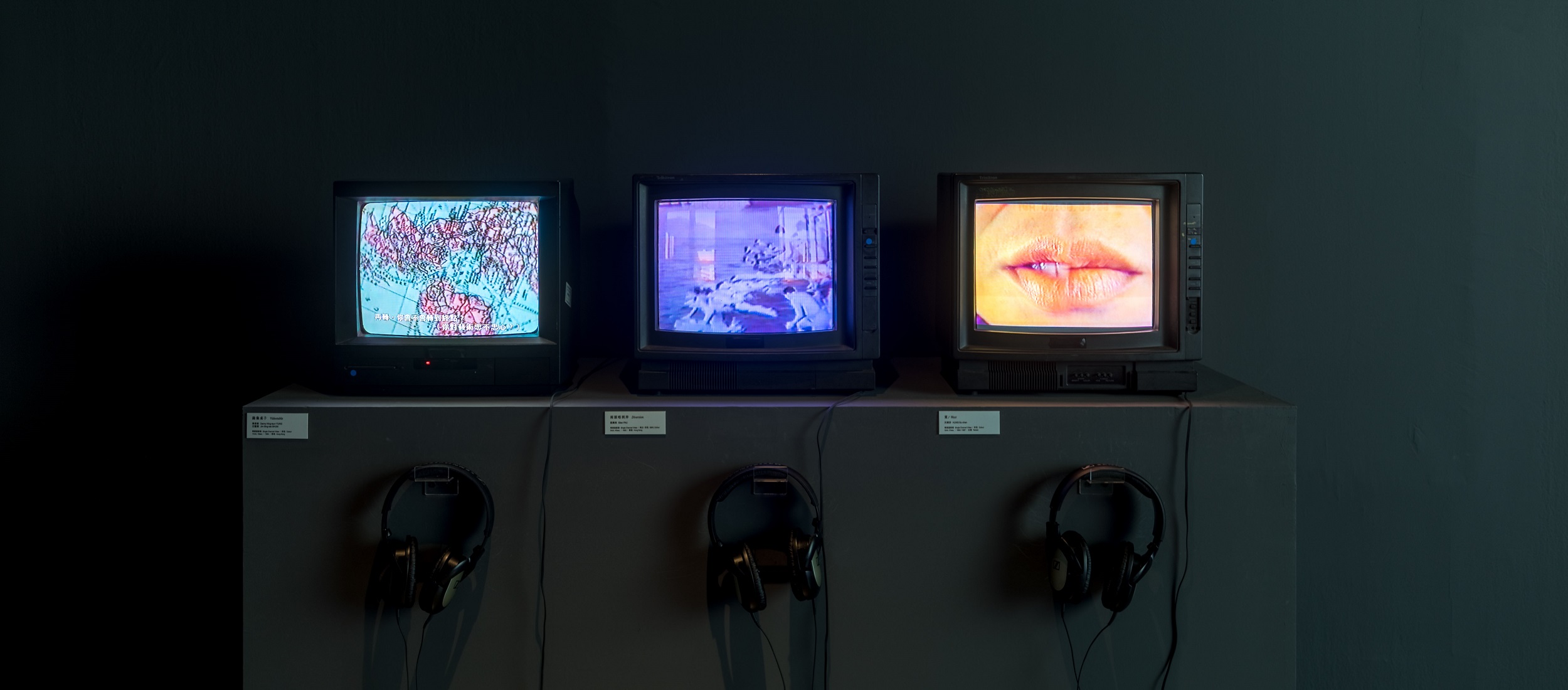

台北當代藝術館 官方網站 Museum of Contemporary Art, Taipei
Sunday 星期日
10AM - 6PM



Sunday 星期日
10AM - 6PM
EXHIBITIONS & EVENTS 展覽活動

2018 / 04 / 07 Sat.
2018 / 06 / 03 Sun.
10:00 - 18:00
地點
venue
MoCA Studio
1980年代初期,錄像藝術在台灣與香港同時崛起,藝術家不約而同地藉由即時、即拍即播的媒介表徵,積極介入社會議題。相較同期的港台劇情片與紀錄片,此種結合創意與政治表態的錄像藝術作品形態在當時尚未引起廣泛關注,顯得弱勢而邊緣。回望1980-1990年代港台錄像藝術,鑒於其歷史事件所展現的獨特感性與洞察力,為當前兩地與中國處於愈顯緊張與對立的政局,帶來重思歷史的契機。
2018年形似歷史事件的回望點,香港回歸足滿20週年,台灣解嚴也超過30年;兩地雖走往政治光譜不同的兩端,但其實卻共同經歷了1984年「中英聯合聲明」、1987年「台灣解除戒嚴令」,1989年「六四天安門」、1997年「香港回歸」。此次參展的17位港台創作者、共計20件作品,本身就是一紙永遠有效的政治聲明與歷史文件。
政治,無疑是所有作品的共同題旨,且與冷戰格局息息相關。自「中英聯合聲明」開始,香港藝術家思辨身分認同危機,試圖在已被人決定的命運中找尋出口,反思未來;台灣創作者則在威權體制期間,彰顯批判國家與媒體的異議人民形象。「六四事件」成為兩地藝術家共同的創痛史:陷於前途未卜與疑懼將來的困境,憶往與出走、省思與批駁,構成回歸以前的香港錄像藝術的雙重基調,而台灣錄像藝術則在批評兩岸國家暴力之際,展露兼容在地國際政局的多重觀點。
如何與歷史事件對峙,音像調度成了藝術家的詩學部署:影音錯體、圖文並置、眾聲喧嘩,在一鏡到底、章節式及蒙太奇等修辭中,繁複且象徵地輪番上陣,炫目迷人。檔案影像與歷史現場連成一氣,在主旋律中突圍逆轉,重塑記憶。
作為政治批判與美學試驗的1980-90s港台錄像藝術,面臨30年後歷史事件的完而未了,它不只是飽含現實意義的歷史文件,更是源起與當代的再次相遇,重啟互動與多元的跨地對話。
Video art arose in Taiwan and Hong Kong around the same time in the early 1980s. Artists employed media that allowed convenient filming and immediate broadcasting to actively intervene in social issues. Comparing to the narrative films and documentaries produced in Hong Kong and Taiwan around the same period, the video art form that combined creativity and political statements did not catch too much attention, and because rather disadvantaged and marginal. Taking a retrospective look on the video art in Hong Kong and Taiwan during the 1980s and 1990s, the unique sensibility and insights demonstrated about historical incidents, in fact, introduce an opportunity to revisit and reflect upon the history given the tense political situation among Hong Kong, Taiwan and China nowadays.
The year 2018 serves as a vantage point to look back on historical incidents; it marks the twentieth anniversary of the handover of Hong Kong as well as the thirtieth anniversary of the lifting of martial law in Taiwan. Although the two places seem to have moved towards opposite ends of the political spectrum, Hong Kong and Taiwan have both undergone the Sino-British Joint Declaration in 1984, the lifting of martial law in Taiwan in 1987, the Tiananmen Square protests in 1989 and the transfer of sovereignty over Hong Kong in 1997. This exhibition features seventeen Hong Kong and Taiwan artists, together with twenty video artworks that are regarded as historical documents, of which their political statements will be forever effective.
Politics is unquestionably a common subject in these works, and it is closely related to the Cold War. Since the signing of the Sino-British Joint Declaration, Hong Kong artists have started a dialectic process regarding the crisis of identity, contemplating on the future and trying to find a way out against the fate that seems predetermined by others; artists in Taiwan have attempted to honour the image of dissidents who have voiced their critique of the state and media under the authoritarian regime. The Tiananmen Square massacre has become a shared trauma by artists in Hong Kong and Taiwan: the unknown future and probable predicaments, remembrance and expatriation as well as reflection and critique consequently formed the duo tones of Hong Kong video art before the handover of Hong Kong; on the other hand, video art in Taiwan demonstrated multiple perspectives that encompassed both local and international political situations while criticising state violence across the Taiwan Strait.
To confront historical incidents, artists have adopted poetic deployment to construct their videos, such as unmatching image and sound, juxtaposing text and picture, and the ensemble of different voices. Furthermore, cinematic rhetorical schemes including long take, chapter, and montage have been used alternatively in an elaborate and symbolic way to create mesmerising works. Archive images and historical scenes are interwoven together to create surprising results and reconstruct memory.
Hong Kong and Taiwan video art in the 1980s and 1990s as a form of political critique and aesthetic experiment is still faced with unresolved historical incidents after three decades. These artworks are not merely historical documents with realistic meanings; they are also a re-encounter between the beginning and the contemporary, which will re-initiate an interactive and diverse cross-regional dialogue.
MORE
LESS
活動名稱
活動地點
活動時間
台北當代藝術館 一樓活動大廳
2018/05/05 Sat.
13:00 - 15:00
台北當代藝術館 一樓活動大廳
2018/05/05 Sat.
15:30 - 17:30
CLOSE
ADMISSION 門票
ADMISSION 門票
CLOSE
著作權聲明
台北當代藝術館尊重他人著作權,台北當代藝術館服務條款亦明定,網友使用台北當代藝術館服務不得侵害他人之著作權,因此,台北當代藝術館呼籲使用者同樣尊重他人之著作權。如果您認為台北當代藝術館網站中之任何網頁內容或網友使用台北當代藝術館服務已侵害您的著作權,建議您利用本處理辦法提出檢舉,台北當代藝術館客服中心將儘速為您處理:
若台北當代藝術館網站中之任何網頁內容或網友使用台北當代藝術館服務已侵害您的著作權,請您填寫:「 著作權侵權通知書」,且依該通知書所載提供下列資料及聲明,並以傳真的方式通知台北當代藝術館:
1、著作權人之簽名、或著作權人之代理人之簽名、相關權利證明文件及著作權之內容,例如:已發行書籍之封面及相關頁面、發表於網路中之網頁內容列印紙本及其網址。
2、侵害著作權之內容所在的網頁及網址。
3、您的聯絡地址、電話等資料。
4、書面聲明您確信該網頁內容的使用行為是未經過著作權人、其代理人或法律的授權。
5、書面聲明您於通知書所載相關資料均為真實,且您是著作權人或著作權人之代理人而為上開聲明。
若台北當代藝術館網站中之任何網頁內容或網友使用台北當代藝術館服務已侵害您的著作權,請您填寫:「 著作權侵權通知書」,且依該通知書所載提供下列資料及聲明,並以傳真的方式通知台北當代藝術館:
1、著作權人之簽名、或著作權人之代理人之簽名、相關權利證明文件及著作權之內容,例如:已發行書籍之封面及相關頁面、發表於網路中之網頁內容列印紙本及其網址。
2、侵害著作權之內容所在的網頁及網址。
3、您的聯絡地址、電話等資料。
4、書面聲明您確信該網頁內容的使用行為是未經過著作權人、其代理人或法律的授權。
5、書面聲明您於通知書所載相關資料均為真實,且您是著作權人或著作權人之代理人而為上開聲明。
隱私權保護政策
台北當代藝術館非常重視用戶的隱私權,因此制訂了隱私權保護政策。請你細讀以下有關隱私權保護政策的內容。
隱私權保護政策的適用範圍
1、隱私權保護政策內容,包括台北當代藝術館如何處理在用戶使用網站服務時收集到的身份識別資料,也包括台北當代藝術館如何處理在商業伙伴與台北當代藝術館合作時分享的任何身份識別資料。
2、隱私權保護政策不適用於台北當代藝術館以外的公司,也不適用於非台北當代藝術館所僱用或管理的人員。
3、台北當代藝術館在你註冊台北當代藝術館帳號、使用台北當代藝術館的產品或服務、瀏覽台北當代藝術館網頁、參加宣傳活動或贈獎遊戲時,台北當代藝術館會收集你的個人識別資料。台北當代藝術館也可以從商業夥伴處取得個人資料。
4、當你在台北當代藝術館註冊時,我們會問及你的姓名、電子郵件地址、出生日期、性別、職位、行業及個人興趣等資料。你在台北當代藝術館註冊成功,並登入使用我們的服務後,我們就會認識你。
5、台北當代藝術館也自動接收並紀錄你瀏覽器上的伺服器數值,包括互聯網協定位址 (IP Address) 、台北當代藝術館cookie中的資料及你要求取用的網頁紀錄。
6、台北當代藝術館會使用資料作以下用途:改進為你提供的廣告及網頁內容、完成你對某項產品的要求及通知你特別活動或新產品。
7、台北當代藝術館不會向任何人出售或出借你的個人識別資料。
8、在以下的情況下,台北當代藝術館會向政府機關、其他人士或公司提供你的個人識別資料:與其他人士或公司共用資料前取得你的同意。
9、需要與其他人士或公司共用你的資料,才能夠提供你要求的產品或服務。
10、向代表台北當代藝術館提供服務或產品的公司提供資料,以便向你提供產品或服務 (若我們沒有事先通知你,這些公司均無權使用我們提供的個人資料,作提供產品或服務以外的其他用途)。
11、應遵守法令或政府機關的要求。
12、我們發覺你在網站上的行為違反 台北當代藝術館服務條款或產品、服務的特定使用指南。
13、其他依「個人資料保護法」或政府法令應公開之資料。
14、為了保護使用者個人隱私, 我們無法為您查詢其他使用者的帳號資料,請您見諒!若您有相關法律上問題需查閱他人資料時,請務必向警政單位提出告訴,我們將全力配合警政單位調查並提供所有相關資料,以協助調查及破案!
15、 台北當代藝術館會到你的電腦設定並取用台北當代藝術館cookie。
16、台北當代藝術館容許在我們網頁上擺放廣告的廠商到你的電腦設定並取用cookie。其他公司將根據其自訂的隱私權保護政策,而並非本政策使用其cookie。其他廣告商或公司不能提取台北當代藝術館的cookie。
17、當台北當代藝術館進行與其產品及服務有關的工作時,會使用 web beacons 進入我們的網站網絡,提取cookie使用。
18、台北當代藝術館賦予你在任何時候修改個人台北當代藝術館帳號資料及偏好設定的權力,包括接受台北當代藝術館通知你特別活動或新產品的決定權。